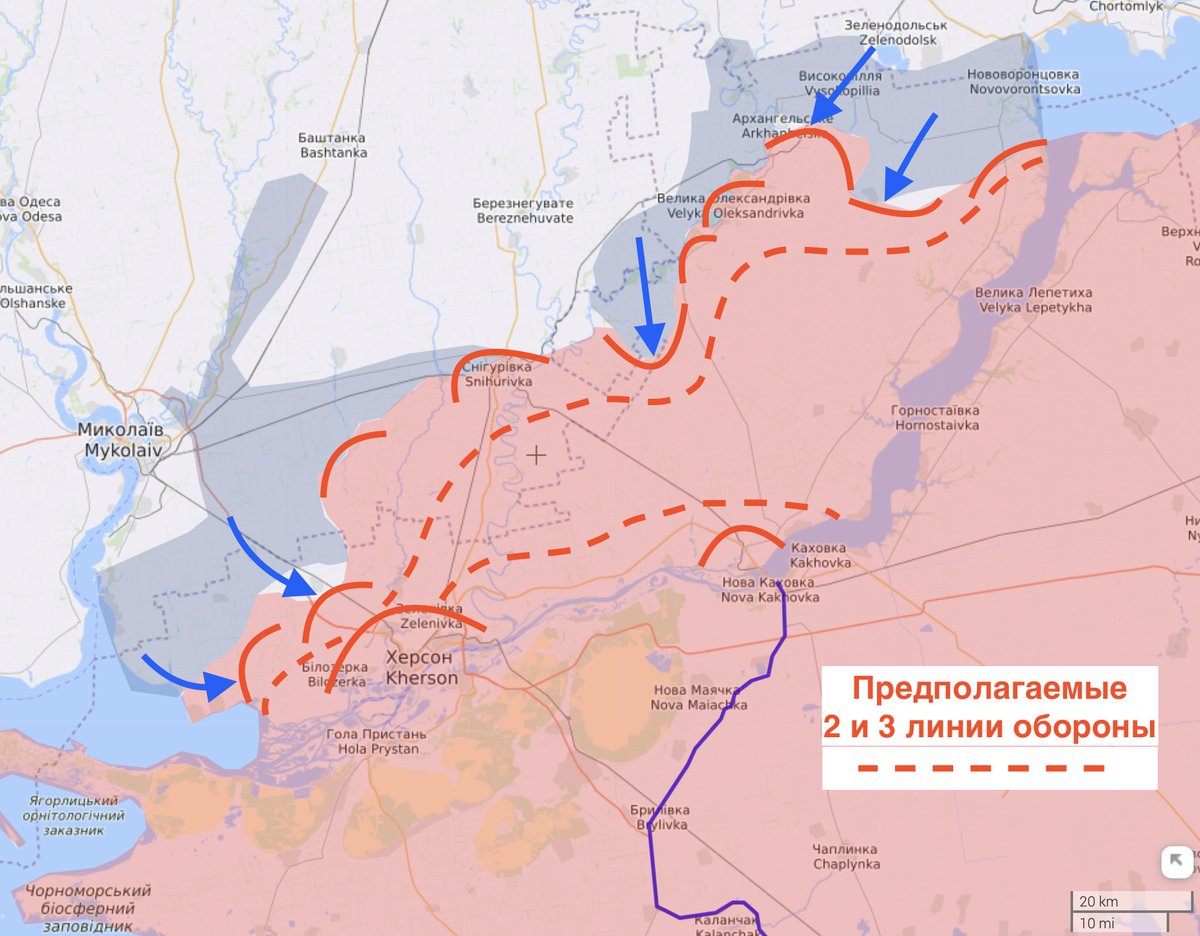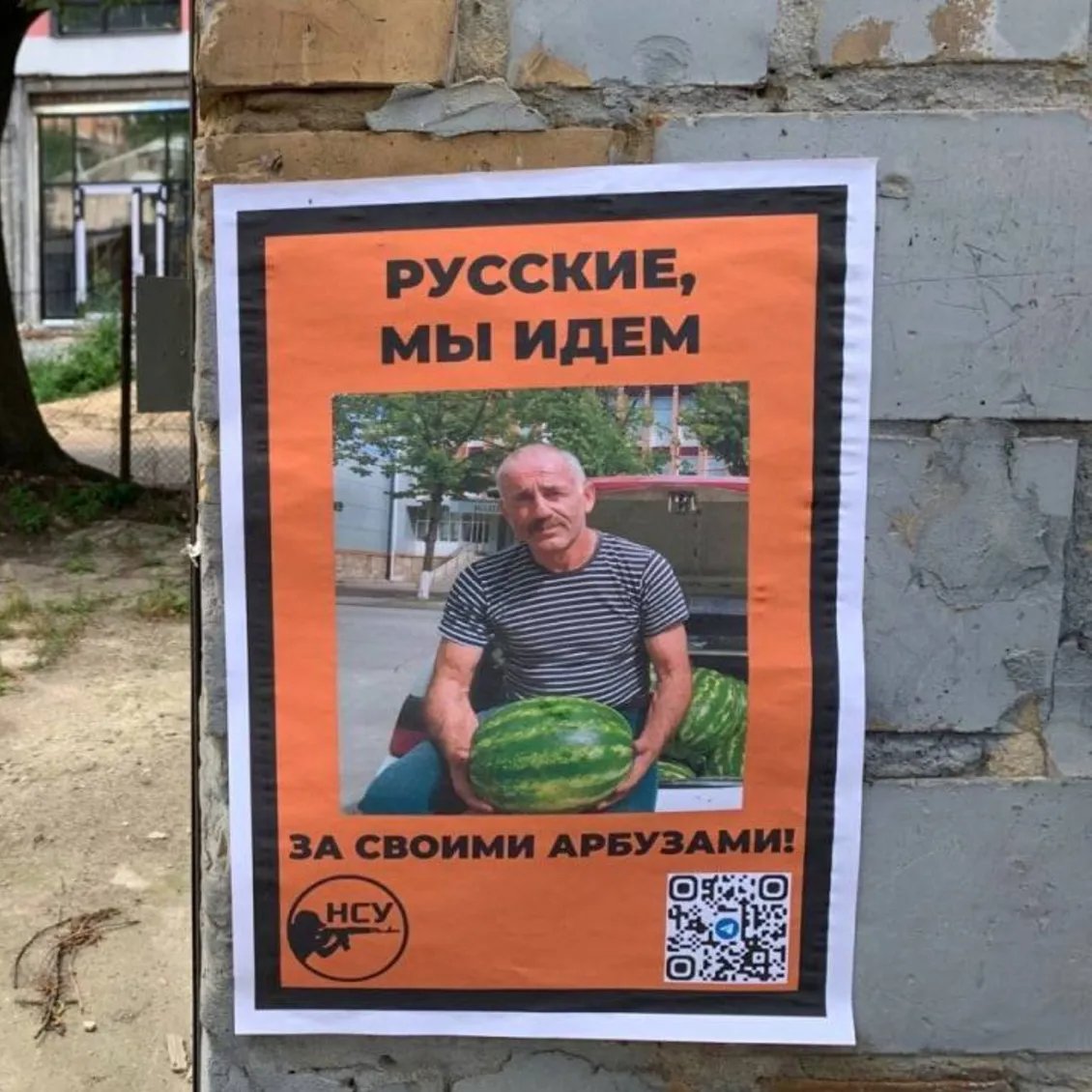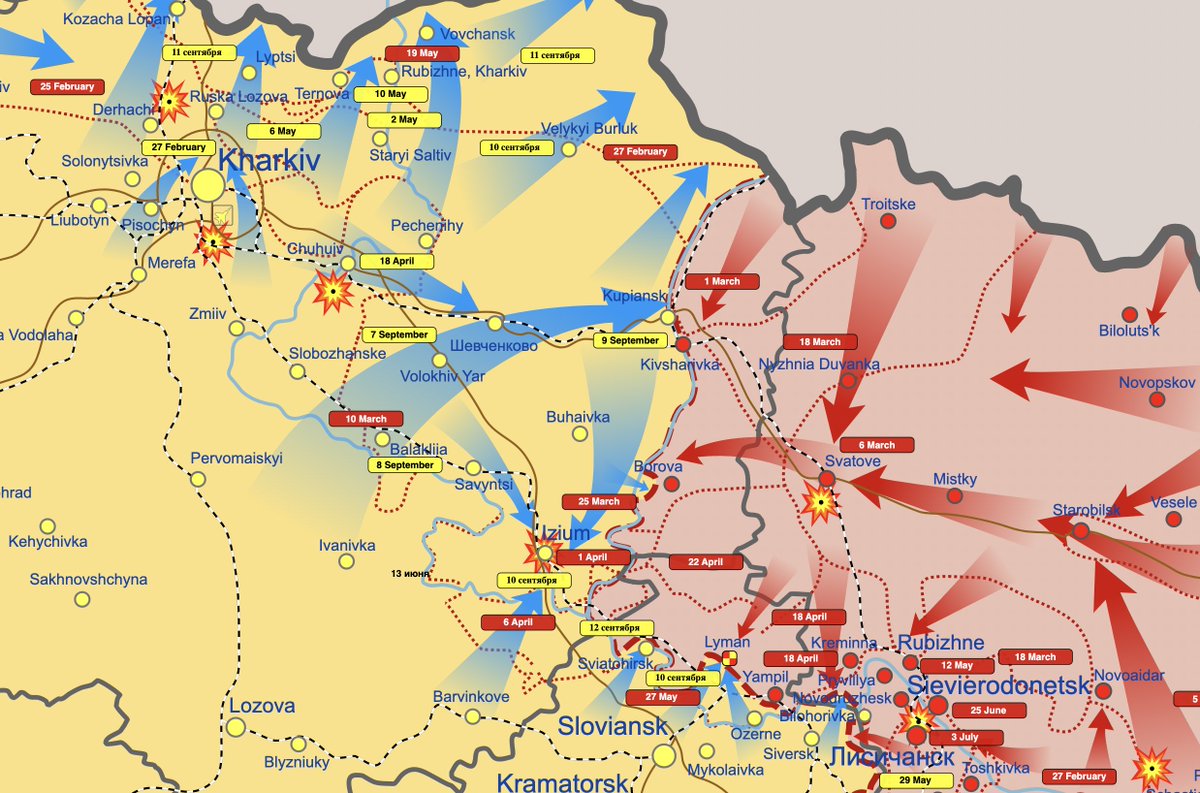
1/ Following @ian_matveev's earlier mega-thread analysing the reasons for Russia's defeat east of Kharkiv (link below), he's now posted a follow-up thread assessing Ukraine's options in the south. An English translation (in 32 parts) follows next. ⬇️
https://twitter.com/ChrisO_wiki/status/1571255027775291392
2/ From @ian_matveev: Kherson will be freed, probably before the end of the year. The only remaining question is how exactly this will happen. In this thread I will discuss three plausible scenarios for a Ukrainian offensive on the right bank of the Dnieper. 

2/ Let me briefly recap the situation. The Russian troops are trapped - the bridges across the Dnieper are destroyed, the supply comes via ferry crossings, and this is clearly not enough. Significant forces were moved to defend the front earlier, including from the "LDNR".
3/ Ukrainian forces, after simultaneously attacking in three to five directions, continue to expand their bridgehead at the Inhulets River and generally press on all sides. But slowly and cautiously. 

4/ The Russian army has built 3 lines of defence (2 and 3 depicted notionally) and is clearly resisting better than in the north. But however Putin's units may act, they are already doomed and will either be defeated or retreat. I will explain why at the end of this thread.
5/ In the meantime, let's look at three options for a Ukrainian offensive.
Option 1: the Armed Forces of Ukraine will continue to do what they are doing now.
Option 1: the Armed Forces of Ukraine will continue to do what they are doing now.
6/ Slowly squeeze the Russian troops out of their positions, capture settlements one by one, forcing the enemy to retreat. Artillery will bombard Putin's army positions, warehouses and crossings. The Russian army will gradually retreat.
7/ Slowly squeeze the Russian troops out of their positions, capture settlements one by one, forcing the enemy to retreat. Artillery will bombard Putin's army positions, warehouses and crossings. The Russian army will gradually retreat.
8/ But I assume that the AFU has two more possible options for an attack in Kherson oblast. These are breakthroughs with quick offensives to Dar'ivka, bypassing Kherson from the north (1) and from the north to Nova Kakhovka (2). 

9/ Again, this is my assumption based on AFU tactics used previously. So, the offensive could develop as follows.
Option 2: After a breakthrough in the Barvinok - Bohorodychne area, the main group should break through in a straight line towards Dar'ivka.
Option 2: After a breakthrough in the Barvinok - Bohorodychne area, the main group should break through in a straight line towards Dar'ivka.

11/ Auxiliary strikes could be made towards Kherson.
There are two difficulties here.
The first is that the AFU prefers to advance on roads, and there are fields here. But as long as it's dry, this shouldn't be an obstacle.
There are two difficulties here.
The first is that the AFU prefers to advance on roads, and there are fields here. But as long as it's dry, this shouldn't be an obstacle.
12/ There are about 24 km to cover, it can be done in a day. There is bocage (mixed woodland and pasture) in the area, which will help with concealment.
The second problem is possible Russian Army strongholds in settlements and villages that would have to be bypassed.

The second problem is possible Russian Army strongholds in settlements and villages that would have to be bypassed.


13/ It is possible to get caught in the crossfire. This means that forces must be allocated to attack them (to tie up enemy infantry units) and artillery to bombard enemy positions. 

14/ As you can see, the route avoids large population centres. And the Russians usually defend them, neglecting the smaller ones. Although in the case of the Kherson region one cannot be 100% sure.
15/ The important thing is that Dar'ivka does not need to be taken - it is enough to block it and its position is conducive to this.
By locking up the Russians here, two roads can be completely blocked at once.
By locking up the Russians here, two roads can be completely blocked at once.
16/ Cut off Kherson from Nova Kakhovka and at the same time from Snihurivka, where Putin's army has clearly established a strong stronghold. It is difficult to cross the Inhulets - it has swampy banks (in green on the map). 

17/ It is difficult to force the Inhulets in this area, so the AFU should not try to get to the other bank, the blockade of Dar'ivka will be enough. 

18/ And then they can get a tight ring around Kherson, cut it off from the Antonivka bridge and completely blockade the Russian troops there.
19/ This would cut the entire Russian bridgehead into two pieces and leave the main Kherson part with less space and room for manoeuvre. Even if the AFU fails to take Kherson, the rest of the territory would be quickly liberated, trapping some Russian units in Snihurivka. 

20/ But such an offensive is risky. After all, near Kherson the defences may be denser than usual, plus there are reserves nearby with MLRS and artillery. There is another option for an offensive that would also defeat the entire grouping, but at a slightly slower pace.
21/ The third option has roughly the same aim – cut the area in two, but by striking towards Nova Kakhovka. Clear and liberate the entire northern part of the bridgehead while repulsing counterattacks in the south. Deprive the Russian army of control of the Nova Kakhovka dam. 

22/ There are even fewer settlements along the way and there is little chance of encountering serious resistance. There is even a road from Davydiv Brid to Beryslav with a good asphalt surface that is up to military standards. 



23/ But the distance is twice as much, from Bruskyns'ke to Nova Kakhovka is 45 km.
Of course, in both cases the key will be a breakthrough of the first line of Russian defence, but I think the AFU can pull it off.
Of course, in both cases the key will be a breakthrough of the first line of Russian defence, but I think the AFU can pull it off.
24/ They have already done it, only they did not develop the offensive further. Now they should concentrate on one powerful strike and then everything will work out.
Especially since there is time to move important units, such as reconnaissance or assault units from Izyum.
Especially since there is time to move important units, such as reconnaissance or assault units from Izyum.
25/ They are already experienced, they have just done all this work, their skills and fighting spirit would help well at Kherson.
26/ I think the elimination of the entire Russian bridgehead on the right bank of the Dnieper is inevitable. Their supply problem is still unresolved. The key problem is the delivery of ammunition and fuel. You can't move large quantities of them by helicopter.
27/ I think the Russian army has already rerouted one or more fuel lines across the Dnieper - it's trivial to throw in hoses with pumps without complicated engineering work. If they haven't even done that, I don't know what to say.
28/ Shells are carried by ferry, much slower than over bridges.
Kherson oblast is probably filled with partisans and sabotage and reconnaissance groups, the proximity to the front and the ease of infiltration are conducive to this.
Kherson oblast is probably filled with partisans and sabotage and reconnaissance groups, the proximity to the front and the ease of infiltration are conducive to this.
29/ We can see indications of a resistance movement in Kherson itself. In general, the main role of such groups is now intelligence-gathering. 



30/ The AFU has more than enough HIMARS in the area (bridges and warehouses to their credit) and has long been attacking various military and political targets in Kherson and the region. Depriving the local occupiers of peace of mind. They don't even have a reliable escape route!
31/ Aircraft will not help either - the only major airfield here is the long-suffering Chornobaivka. This means they will have to fly from Crimea, which is longer. And don't forget about the Ukrainian air defence - Russian planes are shot down every week. 

32/ The AFU has about another month while the weather is more or less suitable for an attack in the fields. Beyond that, it could be more difficult. And it is important to finish the offensive before winter to establish secure positions along the Dnieper. /end 

(Original thread linked below)
https://twitter.com/ian_matveev/status/1571836832274423809
• • •
Missing some Tweet in this thread? You can try to
force a refresh








